HOTPOINT/ARISTON WMF 7025 EU.M User Manual

Instructions for use
WASHING MACHINE
GB |
|
PT |
|
BG |
|
|
|
|
|
|
|
English,1 |
Português,13 |
Български,25 |
|||
Contents |
GB |
|
Installation, 2-3
Unpacking and levelling
Connecting the electricity and water supplies
The first wash cycle
Technical data
CZ SK
Česky,37 Slovensky,49
Care and maintenance, 4
Cutting off the water and electricity supplies Cleaning the washing machine
Cleaning the detergent dispenser drawer Caring for the door and drum of your appliance Cleaning the pump
Checking the water inlet hose
WMF 7025
Precautions and tips, 5
General safety
Disposal
Description of the washing machine, 6-7
Control panel Display
Running a wash cycle, 8
Wash cycles and options, 9
Table of programmes and wash cycles
Wash options
Detergents and laundry, 10
Detergent dispenser drawer
Preparing the laundry
Special wash cycles
Troubleshooting, 11
Service, 12
1

Installation
! This instruction manual should be kept in a GB safe place for future reference. If the washing machine is sold, transferred or moved, make sure that the instruction manual remains with the machine so that the new owner is able to
familiarise himself/herself with its operation and features.
! Read these instructions carefully: they contain vital information relating to the safe installation and operation of the appliance.
Unpacking and levelling
Unpacking
1.Remove the washing machine from its packaging.
2.Make sure that the washing machine has not been damaged during the transportation process. If it has been damaged, contact the retailer and do not proceed any further with the installation process.
3. Remove the 3 protective screws (used during transportation) and the rubber washer with the corresponding spacer, located on the rear part of the
appliance (see figure).
4.Close off the holes using the plastic plugs provided.
5.Keep all the parts in a safe place: you will need them again if the washing machine needs to be moved to another location.
! Packaging materials should not be used as toys for children.
Levelling
1. Install the washing machine on a flat sturdy floor, without resting it up against walls, furniture cabinets or anything else.
2. If the floor is not perfectly level,
compensate for any unevenness by tightening or loosening the adjustable front feet (see figure); the angle of inclination, measured in relation to the worktop, must not exceed 2°. Levelling the machine correctly will provide
it with stability, help to avoid vibrations and excessive noise and prevent it from shifting while it is operating. If it is placed on carpet or a rug, adjust the feet in such a way as to allow a sufficient ventilation space underneath the washing machine.
Connecting the electricity and water supplies
Connecting the water inlet hose
1. Connect the inlet hose by screwing it to a cold water tap using a 3/4 gas threaded connection (see figure).
Before performing the connection, allow the water to run freely until it is perfectly clear.
2. Connect the inlet hose to the
washing machine by screwing it onto the corresponding water inlet of the appliance, which is situated on the top right-hand side of the rear part of the appliance (see figure).
3. Make sure that the hose is not folded over or bent.
!The water pressure at the tap must fall within the range of values indicated in the Technical data table (see next page).
!If the inlet hose is not long enough, contact a specialised shop or an authorised technician.
!Never use second-hand hoses.
!Use the ones supplied with the machine.
2
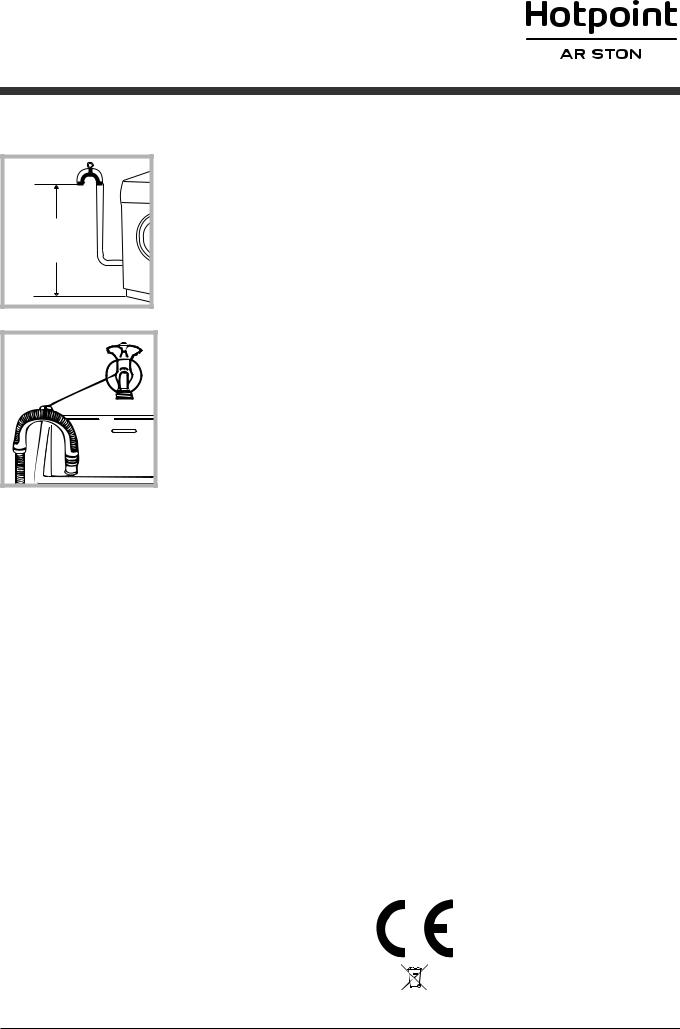
Connecting the drain hose
65 - 100 cm |
Connect the drain hose, without bending it, to a drain duct or
a wall drain situated between 65 and 100 cm from the floor;
alternatively, placed it over the edge
of a basin, sink or tub, fastening the duct supplied to the tap (see figure). The free end of the hose should not be underwater.
! We advise against the use of hose extensions; if it is absolutely necessary, the extension must have the same diameter as the original hose and must not exceed 150 cm in length.
Electrical connections
Before plugging the appliance into the electricity socket, make sure that:
•the socket is earthed and complies with all applicable laws;
•the socket is able to withstand the maximum power load of the appliance as indicated in the Technical data table (see
opposite);
• the power supply voltage falls within the values indicated in the Technical data table (see opposite);
• the socket is compatible with the plug of the washing machine. If this is not the case, replace the socket or the plug.
! The washing machine must not be installed outdoors, even in covered areas. It is extremely dangerous to leave the appliance exposed to rain, storms and other weather conditions.
|
|
|
|
|
|
|
|
! When the washing machine has been |
|
||||||
GB |
|||||||
installed, the electricity socket must remain |
|||||||
|
|||||||
within easy reach. |
|
||||||
! Do not use extension cords or multiple |
|
||||||
sockets. |
|
|
|
|
|||
! The cable should not be bent or |
|
||||||
compressed. |
|
|
|
|
|||
! The power supply cable must only be |
|
||||||
replaced by authorised technicians. |
|
||||||
Warning! The company shall not be held |
|
||||||
responsible in the event that these standards |
|
||||||
are not observed. |
|
||||||
The first wash cycle |
|
||||||
Once the appliance has been installed, and |
|
||||||
before you use it for the first time, run a |
|
||||||
wash cycle with detergent and no laundry, |
|
||||||
using wash cycle number “Auto Clean” (see |
|
||||||
“Cleaning the washing machine”). |
|
||||||
|
|
|
|
|
|||
Technical data |
|
|
|||||
|
|
|
|
|
|
||
Model |
WMF 7025 |
|
|
||||
|
|
|
|
|
|
||
Dimensions |
width 59.5 cm |
|
|
||||
height 85 cm |
|
|
|||||
|
|
|
depth 51,7 cm |
|
|
||
Capacity |
from 1 to 7 kg |
|
|
||||
Electrical |
please refer to the technical |
|
|
||||
data plate fixed to the ma- |
|
|
|||||
connections |
|
|
|||||
chine |
|
|
|||||
|
|
|
maximum pressure |
|
|
||
Water con- |
1 MPa (10 bar) |
|
|
||||
minimum pressure |
|
|
|||||
nections |
|
|
|||||
0.05 MPa (0.5 bar) |
|
|
|||||
|
|
|
drum capacity 46 litres |
|
|
||
Spin speed |
up to 1000 rotations per |
|
|
||||
minute |
|
|
|||||
|
|
|
|
|
|||
Test wash |
|
|
|
|
|||
cycles in |
programme 4; |
|
|
||||
accordance |
|
|
|||||
with re- |
Eco Cotton 60°C. |
|
|
||||
programme 4; |
|
|
|||||
gulations |
|
|
|||||
Eco Cotton 40°C. |
|
|
|||||
1061/2010 |
|
|
|||||
|
|
|
|
||||
1015/2010 |
|
|
|
|
|||
|
|
|
This appliance conforms to |
|
|
||
|
|
|
the following EC Directives: |
|
|
||
|
|
|
- 2004/108/EC (Electroma- |
|
|
||
|
|
|
gnetic Compatibility) |
|
|
||
|
|
|
- 2006/95/EC (Low Voltage) |
|
|
||
|
|
|
- 2012/19/EU (WEEE) |
|
|
||
|
|
|
|
|
|
|
|
|
|
|
|
|
|
|
|
3
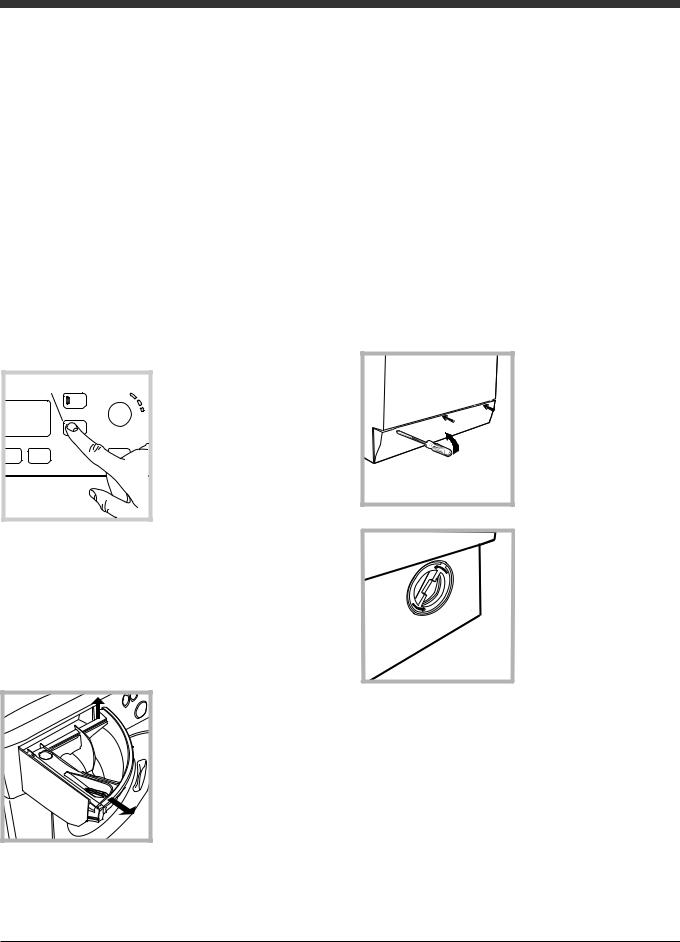
Care and maintenance
|
Cutting off the water and |
|
GB |
||
electricity supplies |
||
|
||
|
• Turn off the water tap after every wash cycle. |
This will limit wear on the hydraulic system inside the washing machine and help to prevent leaks.
• Unplug the washing machine when cleaning it and during all maintenance work.
Cleaning the washing machine
•The outer parts and rubber components of the appliance can be cleaned using a soft cloth soaked in lukewarm soapy water. Do not use solvents or abrasives.
•The washing machine has a “Auto Clean” programme for its internal parts that must be
run with no load in the drum.
A |
To help the wash cycle |
you may want to use |
|
|
either the detergent |
|
(i.e. a quantity 10% |
|
the quantity specified |
|
for lightly-soiled |
|
garments) or special |
|
additives to clean the |
|
washing machine. We |
|
recommend running a |
cleaning programme every 40 wash cycles. To start the programme press button A for 5 seconds (see figure).
The programme will start automatically and will run for about 70 minutes. To stop the cycle press the START/PAUSE button.
Cleaning the detergent dispenser drawer
1 |
2 |
Remove the dispenser by raising it and pulling it out (see figure).
Wash it under running water; this operation should be repeated frequently.
Caring for the door and drum of your appliance
•Always leave the porthole door ajar in order to prevent unpleasant odours from forming.
Cleaning the pump
The washing machine is fitted with a selfcleaning pump which does not require any maintenance. Sometimes, small items (such as coins or buttons) may fall into the pre-chamber which protects the pump, situated in its bottom part.
! Make sure the wash cycle has finished and unplug the appliance.
To access the pre-chamber:
1. using a screwdriver, remove the cover panel on the lower front part of the washing machine
(see figure);
2. unscrew the lid by rotating it anti-
clockwise (see figure): a little water may trickle out. This is perfectly normal;
3.clean the inside thoroughly;
4.screw the lid back on;
5.reposition the panel, making sure the hooks are securely in place before you push it onto the appliance.
Checking the water inlet hose
Check the inlet hose at least once a year. If there are any cracks, it should be replaced immediately: during the wash cycles, water pressure is very strong and a cracked hose could easily split open.
! Never use second-hand hoses.
4

Precautions and tips
! This washing machine was designed and constructed
in accordance with international safety regulations. The GB following information is provided for safety reasons and
must therefore be read carefully.
General safety
•This appliance was designed for domestic use only.
•This appliance can be used by children
aged from 8 years and above and persons with reduced physical, sensory or mental capabilities or lack of experience and knowledge if they have been given
supervision or instruction concerning use of the appliance in a safe way and understand the hazards involved. Children shall not play with the appliance. Cleaning and user maintenance shall not be made by children without supervision.
•Do not touch the machine when barefoot or with wet or damp hands or feet.
•Do not pull on the power supply cable when unplugging the appliance from the electricity socket. Hold the plug and pull.
•Do not open the detergent dispenser drawer while the machine is in operation.
•Do not touch the drained water as it may reach extremely high temperatures.
•Never force the porthole door. This could damage the safety lock mechanism designed to prevent accidental opening.
•If the appliance breaks down, do not under any circumstances access the internal mechanisms in an attempt to repair it yourself.
•Always keep children well away from the appliance while it is operating.
•The door can become quite hot during the wash cycle.
•If the appliance has to be moved, work in a group of two or three people and handle it with the utmost care. Never try to do this alone, because the appliance is very heavy.
•Before loading laundry into the washing machine, make sure the drum is empty.
Disposal
•Disposing of the packaging materials: observe local regulations so that the packaging may be re-used.
•The European Directive 2012/19/EU on Waste Electrical and Electronic Equipment, requires that old household electrical appliances must not be disposed of in the normal unsorted municipal waste stream. Old appliances must be collected separately in order to optimise the recovery and recycling of the materials they contain and reduce the impact on human health and the environment. The crossed out “wheeled bin” symbol on the product reminds you of your obligation, that when you dispose of the appliance it must be separately collected. Consumers should contact their local authority or retailer for information concerning the correct disposal of their old appliance.
5
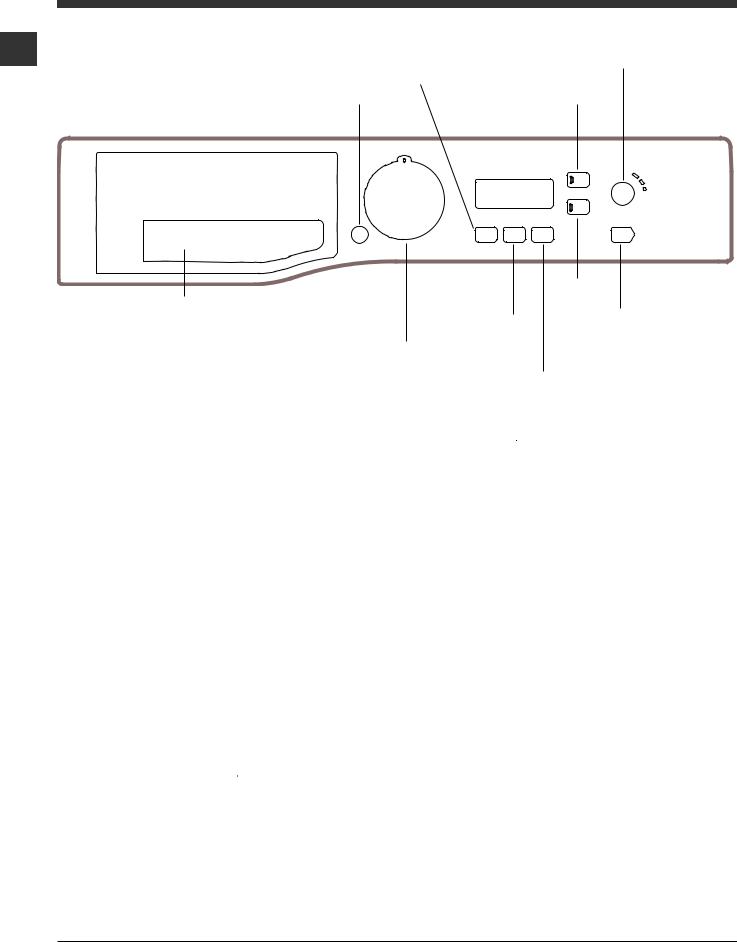
Description of the washing machine
Control panel
GB
TEMPERATURE |
CHILD |
CLEANING |
|
button |
|||
LOCK |
ACTION |
||
|
|||
|
button |
button |
ON/OFF button
DISPLAY
|
|
|
OPTION |
START/PAUSE |
|
|
SPIN |
button and indicator |
|
Detergent dispenser drawer |
WASH |
button and |
light |
|
CYCLE |
button |
indicator light |
|
|
|
SELECTOR |
|
|
|
|
KNOB |
|
DELAY |
|
|
|
|
TIMER |
|
|
|
|
button |
|
Detergent dispenser drawer: used to dispense detergents and washing additives ( see “Detergents and laundry”).
ON/OFF  button: press this briefly to switch the machine on or off. The START/PAUSE indicator light which flashes slowly in a green colour shows that the machine is switched on. To switch off the washing machine during the wash cycle, press and hold the button for approximately 3 seconds; if the button is pressed briefly or accidentally the machine will not switch off.
button: press this briefly to switch the machine on or off. The START/PAUSE indicator light which flashes slowly in a green colour shows that the machine is switched on. To switch off the washing machine during the wash cycle, press and hold the button for approximately 3 seconds; if the button is pressed briefly or accidentally the machine will not switch off.
If the machine is switched off during a wash cycle, this wash cycle will be cancelled.
WASH CYCLE SELECTOR KNOB: used to set the desired wash cycle (see “Table of programmes and wash cycles”).
OPTION button and indicator light: press to select the available options. The indicator light corresponding to the selected option will remain lit.
CLEANING ACTION button  : to select the desired wash intensity.
: to select the desired wash intensity.
TEMPERATURE  button: press to reduce or completely exclude the temperature; the value appears on the display.
button: press to reduce or completely exclude the temperature; the value appears on the display.
SPIN  button: press to reduce or completely exclude the spin cycle; the value appears on the display.
button: press to reduce or completely exclude the spin cycle; the value appears on the display.
DELAY TIMER  button: press to set a delayed start for the selected wash cycle; the delay period appears on the display.
button: press to set a delayed start for the selected wash cycle; the delay period appears on the display.
START/PAUSE button and indicator light: when the green indicator light flashes slowly, press the button to start a wash cycle. Once the cycle has begun the indicator light will remain lit in a fixed manner. To pause the wash cycle, press the button again; the indicator light will flash in an amber colour. If the  symbol is not illuminated, the door may be opened (wait approximately 3 minutes). To start the wash cycle from the point at which it was interrupted, press the button again.
symbol is not illuminated, the door may be opened (wait approximately 3 minutes). To start the wash cycle from the point at which it was interrupted, press the button again.
CHILD LOCK button  : to activate the control panel lock, press and hold the button for approximately 2 seconds. When the symbol
: to activate the control panel lock, press and hold the button for approximately 2 seconds. When the symbol  is illuminated, the control panel is locked (apart from the ON/OFF button). This means it is possible to prevent wash cycles from being modified accidentally, especially where there are children in the home. To deactivate the control panel lock, press and hold the button for approximately 2 seconds.
is illuminated, the control panel is locked (apart from the ON/OFF button). This means it is possible to prevent wash cycles from being modified accidentally, especially where there are children in the home. To deactivate the control panel lock, press and hold the button for approximately 2 seconds.
Standby mode
This washing machine, in compliance with new energy saving regulations, is fitted with an automatic standby system which is enabled after about 30 minutes if no activity is detected. Press the ON-OFF button briefly and wait for the machine to start up again.
6

Display |
GB |
|
The display is useful when programming the machine and provides a great deal of information.
The duration of the available wash cycles and the remaining time of a running cycle appear; if the DELAY TIMER option has been set, the countdown to the start of the selected wash cycle will appear.
Pressing the corresponding button allows you to view the maximum spin speed and temperature values attained by the machine during the set wash cycle, or the values selected most recently, if these are compatible with the set wash cycle.
DOOR LOCKED  indicator light:
indicator light:
The lit symbol indicates that the door is locked. To prevent any damage, wait until the symbol turns off before opening the door (wait approximately 3 minutes).
To open the door while a cycle is in progress, press the START/PAUSE button; if the DOOR LOCKED  symbol is switched off the door may be opened.
symbol is switched off the door may be opened.
7

Running a wash cycle
1. SWITCH THE MACHINE ON. Press the  button;
button;
GB the START/PAUSE indicator light will flash slowly in a green colour.
2.LOAD THE LAUNDRY. Open the porthole door. Load the laundry, making sure you do not exceed the maximum load value indicated in the table of programmes and wash cycles on the following page.
3.MEASURE OUT THE DETERGENT. Pull out the detergent dispenser drawer and pour the detergent into the relevant compartments as described in “Detergents and laundry”.
4.CLOSE THE DOOR.
5.SELECT THE WASH CYCLE. Use the WASH CYCLE SELECTOR knob to select the desired wash cycle. A temperature and spin speed is set for each wash cycle; these values may be adjusted. The duration of the cycle will appear on the display.
6.CUSTOMISE THE WASH CYCLE. Use the relevant buttons:

 Modify the temperature and/or spin speed. The machine automatically displays the maximum temperature and spin speed values set for the selected cycle, or the most recently-used settings if they are compatible with the selected cycle. The
Modify the temperature and/or spin speed. The machine automatically displays the maximum temperature and spin speed values set for the selected cycle, or the most recently-used settings if they are compatible with the selected cycle. The
temperature can be decreased by pressing the  button, until the cold wash “OFF” setting is reached. The spin speed may be progressively reduced by
button, until the cold wash “OFF” setting is reached. The spin speed may be progressively reduced by
pressing the  button, until it is completely excluded (the “OFF” setting). If these buttons are pressed again, the maximum values are restored.
button, until it is completely excluded (the “OFF” setting). If these buttons are pressed again, the maximum values are restored.
! Exception: if the 3 programme is selected, the temperature can be increased up to a value of 90°C.
 Setting a delayed start.
Setting a delayed start.
To set a delayed start for the selected cycle, press the corresponding button repeatedly until the required delay period has been reached. When this option has been activated, the  symbol lights up on the display. To remove the delayed start setting, press the button until the text “OFF” appears on the display.
symbol lights up on the display. To remove the delayed start setting, press the button until the text “OFF” appears on the display.
Set the desired wash intensity.
Option  makes it possible to optimise washing based on the level of soil in the fabrics and on desired wash cycle intensity.
makes it possible to optimise washing based on the level of soil in the fabrics and on desired wash cycle intensity.
Select the wash programme: the cycle will be automatically set to “Normal” as optimised for garments with an average level of soil (this setting is not applicable to the “Wool” cycle, which is automatically set to “Delicate”).
For heavily-soiled garments press  button until the “Intensive” level is reached. This level ensures a high-performance wash due to a larger quantity of
button until the “Intensive” level is reached. This level ensures a high-performance wash due to a larger quantity of
water used in the initial phase of the cycle and due to increased drum rotation. It is useful when removing the most stubborn stains.
It can be used with or without bleach. If you desire bleaching, insert the extra tray compartment (4) into compartment 1. When pouring in the bleach, be careful not to exceed the “max” level marked on the central pivot (see figure pag. 10).
For lightly-soiled garments or a more delicate treatment of the fabrics, press  button until the “Delicate” level is reached. The cycle will reduce drum rotation
button until the “Delicate” level is reached. The cycle will reduce drum rotation
to ensure washing results that are perfect for delicate garments.
Modify the cycle settings.
•Press the button to enable the option; the indicator light corresponding to the button will switch on.
•Press the button again to disable the option; the indicator light will switch off.
!If the selected option is not compatible with the set wash cycle, the indicator light will flash and the option will not be activated.
!The options may affect the recommended load value and/or the duration of the cycle.
7.START THE WASH CYCLE. Press the START/ PAUSE button. The corresponding indicator light will turn green, remaining lit in a fixed manner, and the door will be locked (the DOOR LOCKED  symbol will
symbol will
be lit). To change a wash cycle while it is in progress, pause the washing machine using the START/PAUSE button (the START/PAUSE indicator light will flash slowly in an amber colour); then select the desired cycle and press the START/PAUSE button again.
To open the door while a cycle is in progress, press the START/PAUSE button; if the DOOR LOCKED  symbol is switched off the door may be opened (wait approximately 3 minutes). Press the START/PAUSE button again to restart the wash cycle from the point at which it was interrupted.
symbol is switched off the door may be opened (wait approximately 3 minutes). Press the START/PAUSE button again to restart the wash cycle from the point at which it was interrupted.
8.THE END OF THE WASH CYCLE. This will be indicated by the text “END” on the display; when the DOOR LOCKED  symbol switches off the door may be opened (wait approximately 3 minutes). Open the door, unload the laundry and switch off the machine.
symbol switches off the door may be opened (wait approximately 3 minutes). Open the door, unload the laundry and switch off the machine.
! If you wish to cancel a cycle which has already begun, press and hold the  button. The cycle will be stopped and the machine will switch off.
button. The cycle will be stopped and the machine will switch off.
Load balancing system
Before every spin cycle, to avoid excessive vibrations before every spin and to distribute the load in a uniform manner, the drum rotates continuously at a speed which is slightly greater than the washing rotation speed. If, after several attempts, the load is not balanced correctly, the machine spins at a reduced spin speed. If the load is excessively unbalanced, the washing machine performs the distribution process instead of spinning. To encourage improved load distribution and balance, we recommend small and large garments are mixed in the load.
8
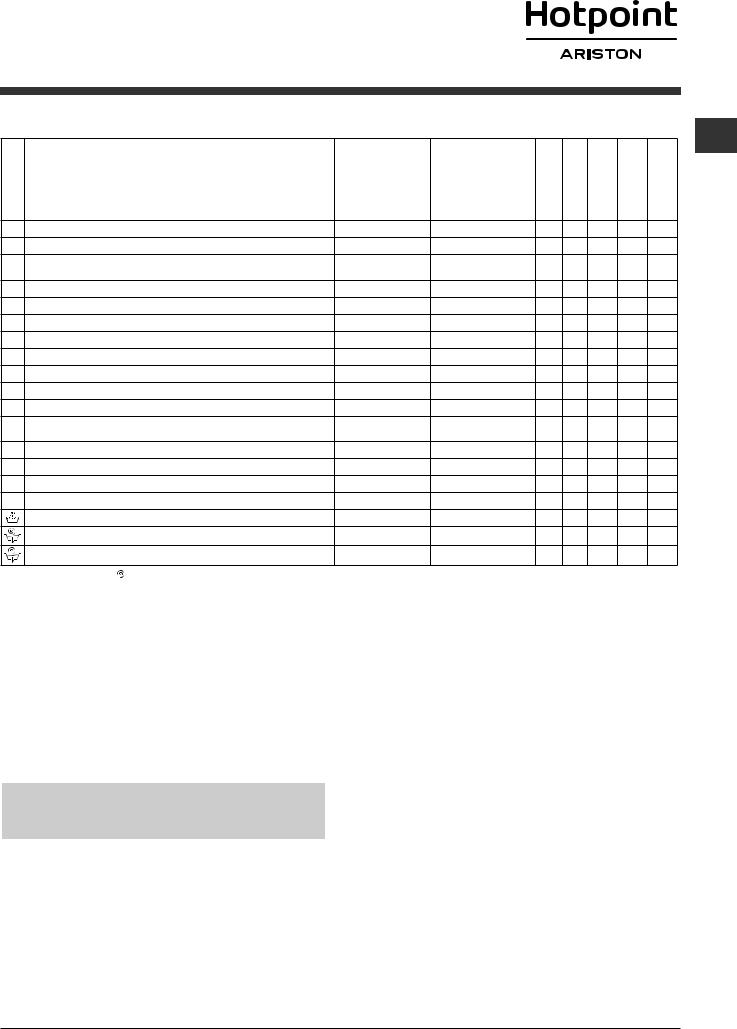
Wash cycles and options
Table of programmes and wash cycles
cycles |
Description of the wash cycle |
|
Wash |
||
|
1Anti Stain
2Whites
3Cotton: lightly soiled resistant and delicate colours.
4Eco Cotton 60° (1): heavily soiled whites and resistant colours.
4Eco Cotton 40° (2): lightly soiled resistant and delicate colours.
5Synthetics: heavily soiled resistant colours.
5Synthetics (3): lightly soiled resistant colours.
6Anti allergy
7Baby
8Wool: for wool, cashmere, etc.
9Delicates
10 |
Fast Wash 60’: to refresh normal soiled garments quickly (not |
suitable for wool, silk and clothes which require washing by hand). |
|
11 |
Cotton 20°: lightly soiled resistant and delicate colours. |
12 |
Eco Cottons |
13 |
Eco Synthetics |
14 |
Eco Fast 30’ |
|
Rinse |
|
Spin and Pump out |
|
Pump out only * |
Max. |
Max. |
|
temp. |
speed |
|
(°C) |
(rpm) |
|
40° |
1000 |
|
60° |
1000 |
|
40° |
1000 |
|
(Max. 90°) |
||
|
||
60° |
1000 |
|
40° |
1000 |
|
60° |
1000 |
|
40° |
1000 |
|
60° |
1000 |
|
40° |
1000 |
|
40° |
800 |
|
30° |
0 |
|
60° |
1000 |
|
20° |
1000 |
|
Cold Water |
1000 |
|
Cold Water |
1000 |
|
Cold Water |
800 |
|
- |
1000 |
|
- |
1000 |
|
- |
OFF |
|
|
|
Detergents
Prewash |
Wash |
Bleach |
Fabric softener |
|
|
|
|
|
|
- |
|
|
|
|
|
- |
|
- |
|
- |
|
- |
|
|
|
|
|
|
|
|
|
- |
|
- |
|
|
|
|
|
- |
|
- |
|
- |
|
- |
|
- |
|
- |
|
- |
|
|
|
- |
|
- |
|
- |
|
- |
|
- |
|
- |
|
- |
- |
|
|
- |
- |
- |
- |
- |
- |
- |
- |
|
|
|
|
GB
Max. load (kg) |
Residual dampness% |
Energy consumptionkWh |
Total water lt |
Cycle duration |
4 |
- |
- |
- |
** |
4 |
- |
- |
- |
** |
7 |
- |
- |
- |
** |
7 |
62 |
1,07 |
52,5 |
195’ |
7 |
62 |
0,81 |
76 |
185’ |
3 |
44 |
0,78 |
33 |
120’ |
3 |
- |
- |
- |
** |
4 |
- |
- |
- |
** |
3 |
- |
- |
- |
** |
1,5 |
- |
- |
- |
** |
1 |
- |
- |
- |
** |
3,5 |
62 |
0,68 |
30 |
60’ |
7 |
- |
- |
- |
** |
7 |
- |
- |
- |
** |
3 |
- |
- |
- |
** |
3 |
70 |
0,05 |
36 |
30’ |
7 |
- |
- |
- |
** |
7 |
- |
- |
- |
** |
7 |
- |
- |
- |
** |
*If you select programme  and exclude the spin cycle, the machine will drain only.
and exclude the spin cycle, the machine will drain only.
**The duration of the wash cycle can be checked on the display.
The length of cycle shown on the display or in this booklet is an estimation only and is calculated assuming standard working conditions. The actual duration can vary according to factors such as water temperature and pressure, the amount of detergent used, the amount and type of load inserted, load balancing and any wash options selected.
1) Test wash cycle in compliance with regulation 1061/2010: set wash cycle 4 with a temperature of 60°C.
This cycle is designed for cotton loads with a normal soil level and is the most efficient in terms of both electricity and water consumption; it should be used for garments which can be washed at 60°C . The actual washing temperature may differ from the indicated value.
2) Test wash cycle in compliance with regulation 1061/2010: set wash cycle 4 with a temperature of 40°C.
This cycle is designed for cotton loads with a normal soil level and is the most efficient in terms of both electricity and water consumption; it should be used for garments which can be washed at 40°C . The actual washing temperature may differ from the indicated value.
For all Test Institutes:
2)Long wash cycle for cottons: set wash cycle 4 with a temperature of 40°C.
3)Long wash cycle for synthetics: set wash cycle 5 with a temperature of 40°C.
Wash options
- If the selected option is not compatible with the set wash cycle, the indicator light will flash and the option will not be activated.
 Prewash
Prewash
If this function is selected, the pre-wash cycle will run; this is useful for removing stubborn stains.
N.B.: Put the detergent in the relevant compartment.
9
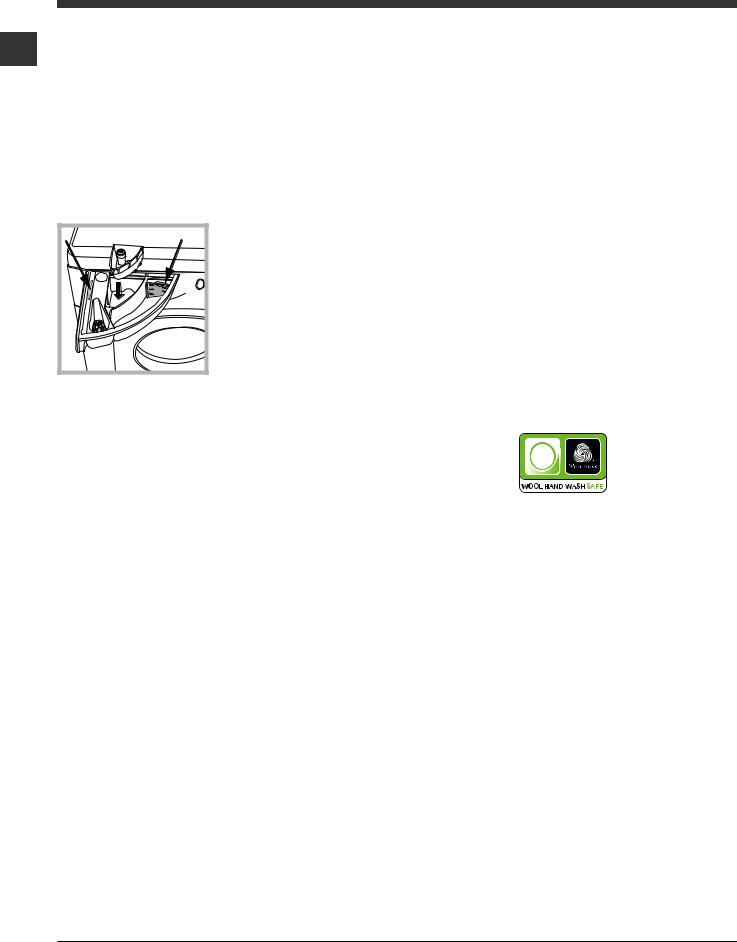
Detergents and laundry
Detergent dispenser drawer
GB
Successful washing results also depend on the correct dose of detergent: adding too much detergent will not necessarily result in a more efficient wash, and may in fact cause build up on the inside of your appliance and contribute to environmental pollution.
!Use powder detergent for white cotton garments, for prewashing, and for washing at temperatures over 60°C.
!Follow the instructions given on the detergent packaging.
!Do not use hand washing detergents; they create too much foam.
B |
A |
MAX |
4 |
|
1 |
3 |
2 |
|
Open the detergent dispenser drawer and pour in the detergent or washing additive, as follows.
compartment 1: Pre-wash detergent (powder)
Before pouring in the detergent, make sure that extra compartment 4 has been removed.
compartment 2: Detergent for the wash cycle (powder or liquid)
If liquid detergent is used, it is recommended that the removable plastic partition A (supplied) be used for proper dosage.
If powder detergent is used, place the partition into slot B. compartment 3: Additives (fabric softeners, etc.)
The fabric softener should not overflow the grid. extra compartment 4: Bleach
Preparing the laundry
•Divide the laundry according to:
-the type of fabric/the symbol on the label
-the colours: separate coloured garments from whites.
•Empty all garment pockets and check the buttons.
•Do not exceed the listed values, which refer to the weight of the laundry when dry:
see “Table of programmes and wash cycles”.
How much does your laundry weigh?
1 sheet 400-500 g
1 pillow case 150-200 g
1 tablecloth 400-500 g
1 bathrobe 900-1,200 g
1 towel 150-250 g
Special wash cycles
Anti Stain: the programme 1 is suitable to heavily-soiled garments with resistant colours. It ensures a washing class that is higher than the standard class (A class). When running the programme, do not mix garments of different colours. We recommend the use of powder detergent. Pre-treatment with special additives is recommended if there are obstinate stains.
Whites: use this cycle 2 to wash white clothes. The programme is designed to maintain the brightness of white clothes over time. Use powder detergent for best results. Anti allergy: use programme 6 to remove major allergens such as pollen, mites, cat’s and dog’s hair.
Baby: use the special wash cycle 7 to remove the soiling typically caused by babies, while removing all traces of detergent from nappies in order to prevent the delicate skin of babies from suffering allergic reactions. The cycle has been designed to reduce the amount of bacteria by using a greater quantity of water and optimising the effect of special disinfecting additives added to the detergent.
Wool - Woolmark Apparel Care - Green:
the wool wash cycle of this machine has been approved by The Woolmark Company for the washing of wool garments labelled as “hand wash” provided that the products are washed according to the instructions on the garment label and those issued by the manufacturer of this washing machine.
In UK, Eire, Hong Kong and India the Woolmark trade mark is a Certification trade mark.
Delicates: use programme 9 to wash very delicate garments
with decorative features, such as diamantes and sequins.
To wash silk garments and curtains select the cycle 9 and set the “Delicate” level from option  . We recommend turning the garments inside out before washing and placing small items into the special bag for washing delicates. Use liquid detergent on delicate garments for best results. Cotton 20° (programme 11) ideal for lightly soiled cotton loads. The effective performance levels achieved at cold temperatures, which are comparable to washing at 40°, are guaranteed by a mechanical action which operates at varying speed, with repeated and frequent peaks.
. We recommend turning the garments inside out before washing and placing small items into the special bag for washing delicates. Use liquid detergent on delicate garments for best results. Cotton 20° (programme 11) ideal for lightly soiled cotton loads. The effective performance levels achieved at cold temperatures, which are comparable to washing at 40°, are guaranteed by a mechanical action which operates at varying speed, with repeated and frequent peaks.
Eco cycles
The Eco Cycles assure energy saving by eliminating the need of heating water and it’s an advantage both to your energy bill and the environment! These innovative Eco programmes (Cottons 12, Synthetics 13 and Fast 30’ 14) are available for various fabrics and different quantity of garment; they have been designed to guarantee a high cleaning action even at low temperature and can be used for lightly to medium soiled loads. Eco Cycles give the best results thanks to an intensified wash action, water optimization and are carried out in the same average time of a standard cycle. For the best washing results with Eco Cycles we recommend the usage of a liquid detergent.
10

Troubleshooting
Your washing machine could occasionally fail to work. Before contacting the Technical Assistance Service (see “ Service”), |
GB |
make sure that the problem cannot be solved easily using the following list. |
Problem:
The washing machine does not switch on.
The wash cycle does not start.
Possible causes / Solutions:
•The appliance is not plugged into the socket fully, or not enough to make contact.
•There is no power in the house.
•The washing machine door is not closed properly.
•The ON/OFF button has not been pressed.
•The START/PAUSE button has not been pressed.
•The water tap has not been opened.
•A delayed start has been set.
The washing machine does not fill with water (the text “H2O” flashes on the display).
The washing machine continuously takes in and drains water.
The washing machine does not drain or spin.
•The water inlet hose is not connected to the tap.
•The hose is bent.
•The water tap has not been opened.
•There is no water supply in the house.
•The pressure is too low.
•The START/PAUSE button has not been pressed.
•The drain hose is not fitted at a height between 65 and 100 cm from the floor
(see “Installation”).
•The free end of the hose is under water (see “Installation”).
•The wall drainage system is not fitted with a breather pipe.
If the problem persists even after these checks, turn off the water tap, switch the appliance off and contact the Technical Assistance Service. If the dwelling is on one of the upper floors of a building, there may be problems relating to water drainage, causing the washing machine to fill with water and drain continuously. Special antidraining valves are available in shops and help to prevent this inconvenience.
•The wash cycle does not include draining: some cycles require the draining process to be enabled manually.
•The drain hose is bent (see “Installation”).
•The drainage duct is clogged.
The washing machine vibrates a lot during the spin cycle.
•The drum was not unlocked correctly during installation (see “Installation”).
•The washing machine is not level (see “Installation”).
•The washing machine is trapped between cabinets and walls (see “Installation”).
The washing machine leaks. |
• The water inlet hose is not screwed on properly (see “Installation”). |
|
• The detergent dispenser drawer is blocked (for cleaning instructions, see “Care |
|
and maintenance”). |
|
• The drain hose is not fixed properly (see “Installation”). |
The “option” and START/PAUSE indicator lights flash rapidly and an error code appears on the display (e.g.: F-01, F-..).
There is too much foam.
•Switch off the machine and unplug it, wait for approximately 1 minute and then switch it back on again.
If the problem persists, contact the Technical Assistance Service.
•The detergent is not suitable for machine washing (it should display the text “for washing machines” or “hand and machine wash”, or the like).
•Too much detergent was used.
11

Service
|
|
|
|
|
Before contacting the Technical Assistance Service: |
||
GB |
|||
• Check whether you can solve the problem alone (see “Troubleshooting”). |
|||
|
• Restart the wash cycle to check whether the problem has been solved. |
||
|
|||
|
• If this is not the case, contact an authorised Technical Assistance Centre. |
||
|
! Always request the assistance of authorised technicians. |
||
Have the following information to hand:
•the type of problem;
•the appliance model (Mod.);
•the serial number (S/N).
This information can be found on the data plate applied to the rear of the washing machine, and can also be found on the front of the appliance by opening the door.
12

Instruções para a utilização






PT
Português
MÁQUINA DE LAVAR ROUPA
Sumário |
PT |
|
Instalação, 14-15
Desembalar e nivelar
Ligações hidráulicas e eléctricas
Primeiro ciclo de lavagem
Dados técnicos
WMF 7025
Manutenção e cuidados, 16
Interromper a alimentação de água e de corrente eléctrica Limpar a máquina de lavar roupa
Limpar a gaveta dos detergentes Cuidados com a porta de vidro e o tambor Limpar a bomba
Verificar o tubo de alimentação de água
Precauções e conselhos, 17
Segurança geral
Eliminação
Descrição da máquina de lavar roupa, 18-19
Painel de comandos Visor
Como efectuar um ciclo de lavagem, 20
Programas e opções, 21
Tabela dos programas
Opções de Lavagem
Detergentes e roupa, 22
Gaveta dos detergentes
Preparar a roupa
Programas especiais
Anomalias e soluções, 23
Assistência, 24
13
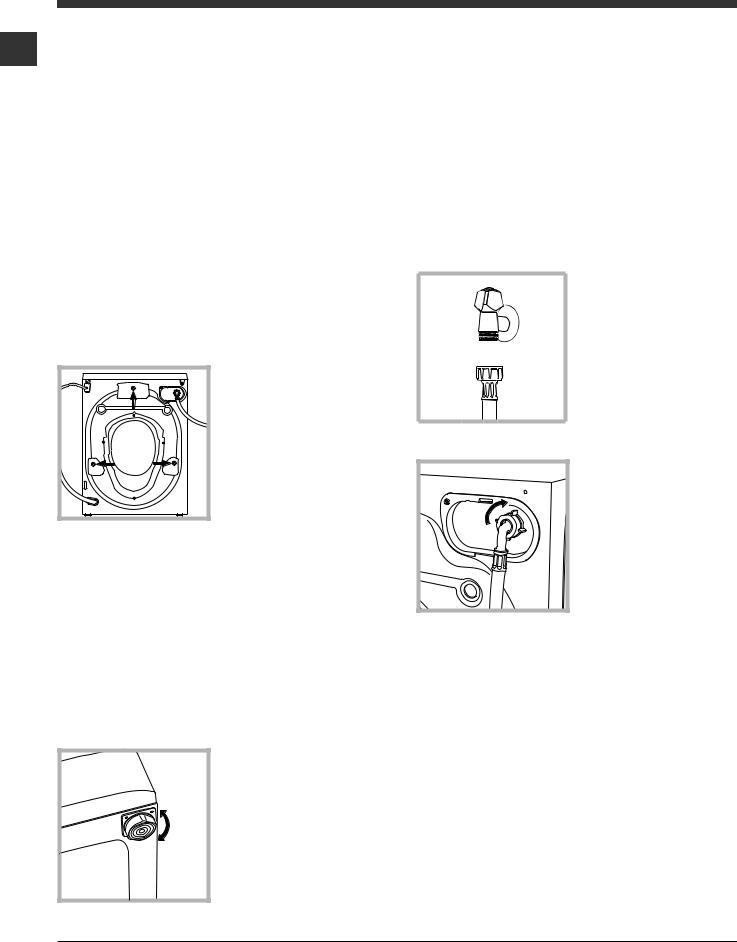
Instalação
! É importante guardar este livrete para
PT poder consultá-lo a qualquer momento. Se a máquina for vendida, cedida ou transferida, certifique-se que este livrete permaneça com a máquina para informar o novo proprietário acerca do seu funcionamento e das respectivas advertências.
! Leia com atenção estas instruções: há importantes informações acerca da instalação, da utilização e da segurança.
Desembalar e nivelar
Desembalar
1.Tire a máquina de lavar roupa da embalagem.
2.Verifique se a máquina de lavar roupa sofreu danos no transporte. Se estiver danificada não efectue a sua ligação e contacte o revendedor.
3. Tire os 3 parafusos de protecção para
o transporte e a borrachinha com o respectivo calço, situados na parte
traseira (veja a figura).
4.Tape os furos com as tampas em plástico fornecidas.
5.Guarde todas as peças: se for necessário transportar a máquina de lavar roupa, terão de ser montadas outra vez.
! Embalagens não são brinquedos para as crianças!
Nivelamento
1. Instale a máquina de lavar roupa sobre um pavimento plano e rígido, sem encostá-la em paredes, móveis nem outro.
2. Se o pavimento não for perfeitamente horizontal, para compensar qualquer
irregularidade, desatarraxe ou atarraxe os pés dianteiros (veja a figura); ; o ângulo de inclinação, medido no plano de trabalho,
não deve ultrapassar 2°.
Um cuidadoso nivelamento dá estabilidade à máquina e evita vibrações, ruídos e deslocamentos durante o funcionamento. Se houver tapete ou alcatifa, regule os pés
De modo a que debaixo da máquina de lavar roupa haja um espaço suficiente para ventilação.
Ligações hidráulicas e eléctricas
Ligação do tubo de alimentação da
água
1. Realize a ligação do tubo de alimentação parafusando-o a uma torneira de água fria com bocal de rosca de 3/4 gás (veja a figura).
Antes de realizar esta ligação, haja a água escorrer até estar límpida.
2. Ligue o tubo de alimentação na máquina de lavar roupa atarraxando-o no apropriado fornecimento da água, na parte traseira, em cima à direita (veja a figura).
3. Tome cuidado para o tubo não ser dobrado nem esmagado.
! A pressão hídrica da torneira deve ser entre os valores da tabela dos Dados técnicos (veja a página ao lado).
!Se o comprimento do tubo de alimentação não for suficiente, contacte uma oficina especializada ou um técnico autorizado.
!Nunca utilize tubos já usados.
!Utilize aqueles fornecidos com a máquina.
14
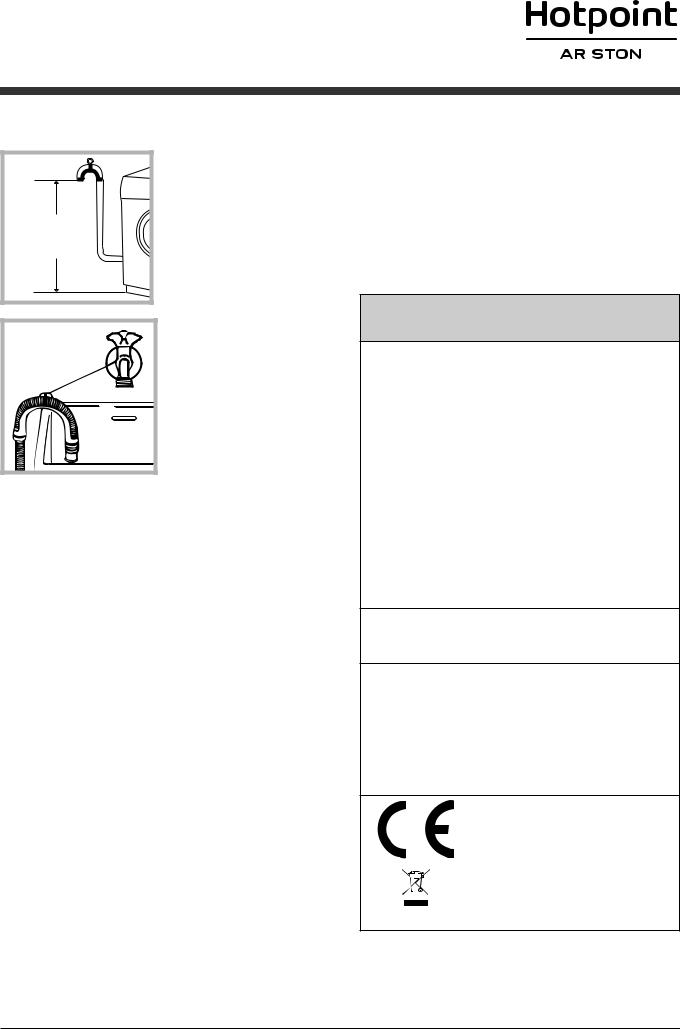
Ligação do tubo de descarga
65 - 100 cm |
Ligue o tubo de descarga, sem dobrálo, a uma conduta de descarga ou a uma descarga na parede situada entre 65 e 100 cm de altura do chão;
ou coloque na beira de um lavabo ou de uma banheira, prenda na torneira a guia fornecida (veja a figura). A ponta solta do tubo de descarga não deve permanecer emergida na água.
! É desaconselhado empregar tubos de extensão; mas se for indispensável, a extensão deve ter o mesmo diâmetro do tubo original e não medir mais de 150 cm de comprimento.
Ligação eléctrica
Antes de ligar a ficha na tomada eléctrica, certifique-se que:
•a tomada tenha uma ligação à terra e seja nos termos da legislação;
•atomadatenhaacapacidadeparasuportara carga máxima de potência da máquina, indicada na tabela dos Dados técnicos (veja ao lado);
•a tensão de alimentação seja entre os valores indicados na tabela dos Dados técnicos (veja ao lado);
•a tomada seja compatível com a ficha da máquina de lavar roupa. Se não for, substitua a tomada ou a ficha.
!Esta máquina de lavar roupa não deve ser instalada ao aberto, nem mesmo abrigada, porque é muito perigoso deixá-la exposta à chuva e às tempestades.
!Depois de ter instalado a máquina de lavar roupa, o acesso à tomada eléctrica deve ser fácil.
!Não empregue extensões nem fichas múltiplas.
!O cabo não deve ser dobrado nem apertado.
!O cabo de alimentação deve ser substituído somente por técnicos autorizados.
|
|
|
|
Atenção! O fabricante declina toda a |
|
||
PT |
|||
responsabilidade se estas regras não forem |
|||
|
|||
respeitadas. |
|
||
|
|||
Primeiro ciclo de lavagem
Después de la instalación y antes del uso, realice un ciclo de lavado con detergente y sin ropa, seleccionando el programa “Auto Limpieza” (ver “Limpiar la lavadora”).
Dados técnicos
Modelo |
WMF 7025 |
|
|
|
|
|
largura 59,5 cm |
|
Medidas |
altura 85 cm |
|
|
profundidade 51,7 cm |
|
Capacidade |
de 1 a 7 kg |
|
|
|
|
Ligações |
veja a placa das caracterí- |
|
sticas técnicas colocada na |
||
eléctricas |
||
máquina |
||
|
||
|
pressão máxima |
|
Ligações |
1 MPa (10 bars) |
|
pressão mínima |
||
hídricas |
||
0,05 MPa (0,5 bar) |
||
|
||
|
capacidade do tambor 46 litros |
Velocidade
da centrifuaté 1000 rotações por minuto gação
Programas |
|
de |
Programa 4: Eco Algodón |
controlo |
|
conforme |
60°C. |
as regu- |
Programa 4: Eco Algodón |
lamentos |
40°C. |
1061/2010 e 1015/2010
Esta aparelhagem é em conformidade com as seguintes Directivas Comunitárias:
- 2004/108/CE (Compatibilidade Electromagnética)
- 2012/19/EU (WEEE)
- 2006/95/CE (Baixa Tensão)
15
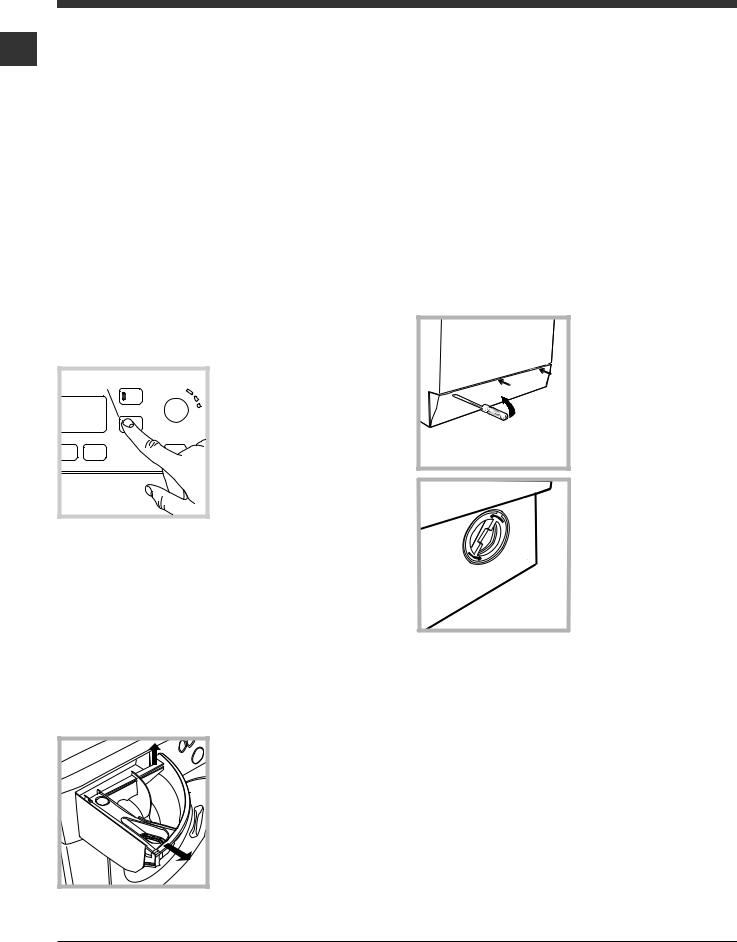
Manutenção e cuidados
Interromper a alimentação de
PT água e de corrente eléctrica
•Feche a torneira da água depois de cada lavagem. Desta maneira diminuiu-se o desgaste do sistema hidráulico da máquina de lavar roupa e elimina-se o risco de inundação.
•Tire a ficha da tomada eléctrica quando for limpar a máquina de lavar roupa e durante os trabalhos de manutenção.
Limpar a máquina de lavar roupa
•A parte externa e as peças em borracha podem ser limpas com um pano molhado com água morna e sabão. Não empregue solventes nem abrasivos.
•A máquina de lavar roupa dispõe de um programa de “Auto Limpeza” das suas partes internas que deve ser efectuado sem carga
alguma dentro do tambor.
A O detergente (na quantidade
equivalente ao 10% daquela recomendada para peças pouco sujas) ou aditivos específicos para a limpeza da máquina de lavar roupa, poderão ser utilizados como coadjuvantes
no programa de lavagem. Recomenda-se efectuar o programa de limpeza a cada 40 ciclos de lavagem.
Para activar o programa, pressione a tecla A por 5 segundos (ver figura).
O programa iniciará automaticamente e terá uma duração de aproximadamente 70 minutos. Para terminar o ciclo, carregar no botão START/PAUSE button.
Limpar a gaveta dos detergentes
1 |
2 |
Para tirar a gaveta, erga-a e puxe-a para fora (veja a figura). Lave-a com água corrente; esta limpeza deve ser efectuada frequentemente.
Cuidados com a porta de vidro e o tambor
•Deixe a porta sempre entreaberta para evitar que se formem odores desagradáveis.
Limpar a bomba
Esta máquina de lavar roupa é equipada com uma bomba com limpeza automática que não precisa de operações de manutenção. Entretanto pode acontecer que pequenos objectos (moedinhas, botões) caiam na précâmara que protege a bomba, situada na parte inferior da mesma.
! Certifique-se que o ciclo de lavagem tenha terminado e tire a ficha da tomada.
Para obter acesso à pré-câmara:
1. tire o painel de cobertura da parte dianteira da máquina de lavar roupa com ajuda de uma chave de fendas (veja a figura);
2. desenrosque a tampa girando-a no sentido anti-horário (veja a figura). é normal que perca um pouco de água;
3.limpe o interior com cuidado;
4.enrosque outra vez a tampa;
5.monte outra vez o painel, certifique-se, antes de empurrá-la na máquina, que os ganchos foram colocados nas respectivas ranhuras.
Verificar o tubo de alimentação de água
Verifique o tubo de alimentação pelo menos uma vez por ano. Se houver rachaduras ou fendas, será necessário substitui-lo: durante as lavagens as fortes pressões podem provocar repentinas quebras.
! Nunca utilize tubos já usados.
16

Precauções e conselhos
! Esta máquina de lavar roupa foi projectada e fabricada em conformidade com os regulamentos internacionais de segurança. Estas advertências são fornecidas por razões de segurança e devem ser lidas com atenção.
Segurança geral
•Este aparelho foi projectado exclusivamente para um uso doméstico.
•Este aparelho pode ser utilizado por crianças com
mais de 8 anos e por pessoas com capacidades físicas, sensoriais ou mentais reduzidas ou com experiência e conhecimentos insuficientes, caso sejam supervisionadas ou caso tenham recebido instruções adequadas em relação ao uso do aparelho de forma segura, compreendendo os perigosassociados.Ascriançasnãodevembrincar com o aparelho. A manutenção e limpeza não devemserefectuadasporcriançassemsupervisão.
•Não toque na máquina com os pés descalços nem com as mãos ou os pés molhados ou húmidos.
•Não puxe o cabo eléctrico para tirar a ficha da tomada, pegue a ficha mesmo.
•Não abra a gaveta dos detergentes enquanto a máquina estiver a funcionar.
•Não toque a água de descarga, que poderá chegar a temperaturas altas.
•Em nenhum caso force a porta para abri-la: poderá danificar o mecanismo de segurança que a protege contra aberturas acidentais.
•Se houver avarias, em nenhum caso mexa nos mecanismos internos para tentar reparar.
•Verifique sempre que criança não se aproximem da máquina a funcionar.
•Durante a lavagem a porta de vidro tende a aquecer-se.
•Se for preciso deslocá-la, são precisas pelo menos duas ou três pessoas, com a máxima atenção. Nunca sozinho porque a máquina é muito pesada.
•Antesdecolocararoupacontrolequeotamborestejavazio.
Sistema de balanceamento da carga
Antes de cada centrifugação, para evitar vibrações excessivas e para distribuir a carga em modo uniforme, o tambor efectua algumas rotações a uma velocidade levemente superior àquela de lavagem. Se no fim
de repetidas tentativas a carga ainda não estiver correctamente balanceada, a máquina efectuará a centrifugação com uma velocidade inferior àquela prevista. No caso de um excessivo desequilíbrio, a máquina de lavar roupa efectuará a distribuição ao invés da centrifugação. Para favorecer uma melhor distribuição da carga e o seu correcto balanceamento, aconselha-se misturar peças grandes com peças pequenas.
Eliminação
•Eliminação do material de embalagem:
obedeça os regulamentos locais, de maneira que as embalagens possam ser reutilizadas.
• A directiva Europeia 2012/19/EU relativa aos resíduos
de equipamentos eléctricos e electrónicos prevê PT que os electrodomésticos não devem ser eliminados
no normal fluxo dos resíduos sólidos urbanos. Os aparelhos que deixaram de ser utilizados devem ser recolhidos separadamente para optimizar a taxa de recuperação e reciclagem dos materiais que os compõem e impedir potenciais danos à saúde e ao
meio ambiente. O símbolo do contentor de lixo barrado com uma cruz está presente em todos os produtos para lembrar o dever de recolha selectiva. Para mais informações sobre o correcto desmantelamento
dos electrodomésticos, contacte o serviço público especializado ou os revendedores.
17

Descrição da máquina de lavar roupa
|
|
|
|
|
|
|
|
|
Painel de comandos |
Tecla |
|
|
|
PT |
|
|
|
|
||
|
|
BLOQUEIO |
|
|
||
|
|
Tecla da |
DAS |
|
Tecla |
|
|
|
|
||||
|
|
Tecla ON/OFF TEMPERATURA |
TECLAS |
|
INTENSIDADE |
|
|
|
|
|
|
|
LAVAGEM |
|
|
|
|
|
||
|
|
|
|
|
|
|
|
|
|
|
|
|
|
Visor
|
Selector de |
Tecla e indicador |
|
|
luminoso |
||
|
PROGRAMAS |
||
|
START/PAUSE |
||
Gaveta dos detergentes |
|
||
Tecla |
Teclase indicadores |
||
|
|||
|
CENTRIFUGAÇÃO |
||
|
luminosos de |
||
|
|
||
|
Tecla |
OPÇÃO |
|
|
INÍCIO |
|
|
|
POSTERIOR |
|
Gaveta dos detergentes: para colocar detergentes e aditivos (veja “Detergentes e roupa”).
Tecla ON/OFF  : carregue brevemente na tecla para ligar ou desligar a máquina. O indicador luminoso START/ PAUSE que pisca lentamente com a cor verde, indica que a máquina está ligada. Para desligar a máquina de lavar roupa durante a lavagem, é necessário manter pressionado a tecla por mais tempo, aproximadamente 3 segundos; uma pressão breve ou acidental não anulará o funcionamento da máquina. O desligar a máquina durante uma lavagem em curso anula a própria lavagem.
: carregue brevemente na tecla para ligar ou desligar a máquina. O indicador luminoso START/ PAUSE que pisca lentamente com a cor verde, indica que a máquina está ligada. Para desligar a máquina de lavar roupa durante a lavagem, é necessário manter pressionado a tecla por mais tempo, aproximadamente 3 segundos; uma pressão breve ou acidental não anulará o funcionamento da máquina. O desligar a máquina durante uma lavagem em curso anula a própria lavagem.
Selector de PROGRAMAS: para seleccionar o programa desejado (veja a “Tabela dos programas”).
Botões e indicadores luminosos OPÇÃO: para seleccionar as opções disponíveis. O indicador luminoso correspondente à opção seleccionada permanecerá aceso.
Tecla INTENSIDADE LAVAGEM  : pressione para seleccionar a intensidade de lavagem desejada.
: pressione para seleccionar a intensidade de lavagem desejada.
Tecla TEMPERATURA  : pressionar para reduzir ou excluir a temperatura; o valor é indicado no visor.
: pressionar para reduzir ou excluir a temperatura; o valor é indicado no visor.
Tecla CENTRIFUGAÇÃO  : pressionar para reduzir ou excluir completamente a centrifugação; o valor é indicado no visor.
: pressionar para reduzir ou excluir completamente a centrifugação; o valor é indicado no visor.
Tecla INÍCIO POSTERIOR 

 : pressionar para programar um início atrasado do programa escolhido; o atraso é indicado no visor.
: pressionar para programar um início atrasado do programa escolhido; o atraso é indicado no visor.
Tasto com indicador luminoso START/PAUSE: quando o indicador luminoso verde, acender intermitentemente, carregue na tecla para iniciar uma lavagem. Quando o ciclo iniciar, o indicador permanecerá aceso fixo. Para colocar em pausa a lavagem, carregar novamente no botão; o indicador ficará intermitente com uma luz laranja. Se o símbolo  não estiver iluminado, será possível abrir a porta de vidro (aguarde aproximadamente 3 minutos). Para fazer iniciar a lavagem do ponto em que foi interrompida, carregar novamente na tecla.
não estiver iluminado, será possível abrir a porta de vidro (aguarde aproximadamente 3 minutos). Para fazer iniciar a lavagem do ponto em que foi interrompida, carregar novamente na tecla.
Tecla BLOQUEIO DAS TECLAS  : para activar o bloqueio do painel de comandos, manter pressionada a tecla durante aproximadamente 2 segundos. O
: para activar o bloqueio do painel de comandos, manter pressionada a tecla durante aproximadamente 2 segundos. O
símbolo  aceso indica que o painel de comandos está bloqueado (à excepção da tecla ON/OFF). Deste modo, impedem-se modificações acidentais dos programas, sobretudo se houver crianças em casa. Para desactivar o bloqueio do painel de comandos, mantenha pressionada a tecla durante aproximadamente 2 segundos.
aceso indica que o painel de comandos está bloqueado (à excepção da tecla ON/OFF). Deste modo, impedem-se modificações acidentais dos programas, sobretudo se houver crianças em casa. Para desactivar o bloqueio do painel de comandos, mantenha pressionada a tecla durante aproximadamente 2 segundos.
Modalidade de Stand by
Esta máquina de lavar roupa, em conformidade com as novas normas sobre a economia energética, dispõe de um sistema de desligação automática (stand by) que entra em função aproximadamente 30 minutos depois, no caso de inutilização. Carregue brevemente no botão ON/OFF e aguarde até a reactivação da máquina.
18
